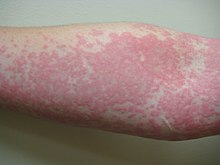| Solar urticaria | |
|---|---|
 | |
| Formation of wheals on the arm | |
| Specialty | Dermatology |
Solar urticaria (SU) is a rare condition in which exposure to ultraviolet or UV radiation, or sometimes even visible light, induces a case of urticaria or hives that can appear in both covered and uncovered areas of the skin.[1][2] It is classified as a type of physical urticaria.[3] The classification of disease types is somewhat controversial. One classification system distinguished various types of SU based on the wavelength of the radiation that causes the breakout; another classification system is based on the type of allergen that initiates a breakout.[4][5]
The agent in the human body responsible for the reaction to radiation, known as the photoallergen, has not yet been identified.[6] The disease itself can be difficult to diagnose properly because it is so similar to other dermatological disorders, such as polymorphous light eruption or PLE.[7] The most helpful test is a diagnostic phototest, a specialized test which confirms the presence of an abnormal sunburn reaction. Once recognized, treatment of the disease commonly involves the administration of antihistamines, and desensitization treatments such as phototherapy.[1] In more extreme cases, the use of immunosuppressive drugs and even plasmapheresis may be considered.[8]
The initial discovery of the disease is credited to P. Merklen in 1904, but it did not have a name until the suggestion of "solar urticaria" was given by William Waddell Duke in 1923.[9][10] However, their research contributed to the study of this uncommon disease. More than one hundred cases have been reported in the past century.[11]
- ^ a b Cite error: The named reference
Dermnetnzwas invoked but never defined (see the help page). - ^ Lugović, Mihić L; Bulat, V; Situm, M; Cavka, V; Krolo, I (October 2008). "Allergic hypersensitivity skin reactions following sun exposure". Collegium Antropologicum. 32 (2): 153–7. PMID 19138019.
- ^ Grammer, Leslie; Patterson, Roy; Greenberger, Paul A. (2002). Patterson's Allergic Diseases: Treatment and Prevention. Lippincott Williams & Wilkins. p. 244. ISBN 978-0-7817-2386-2.
- ^ Cite error: The named reference
Clinicalwas invoked but never defined (see the help page). - ^ Cite error: The named reference
pathogenesiswas invoked but never defined (see the help page). - ^ Cite error: The named reference
Photodermatologywas invoked but never defined (see the help page). - ^ Cite error: The named reference
allergicwas invoked but never defined (see the help page). - ^ Cite error: The named reference
urticaria.org.ukwas invoked but never defined (see the help page). - ^ Duke, William Waddell (1923-06-23). "Urticaria Caused by Light: Preliminary Report". Journal of the American Medical Association. 80 (25): 1835–1838. doi:10.1001/jama.1923.02640520017004. ISSN 0002-9955.
- ^ Hölzle, Erhard; Dawe, Robert (2019). "The Idiopathic Photodermatoses and Skin Testing". Harper's Textbook of Pediatric Dermatology (4th ed.). John Wiley & Sons. pp. 943–956. doi:10.1002/9781119142812.ch77. ISBN 9781119142812. S2CID 213560400.
- ^ Cite error: The named reference
vitrowas invoked but never defined (see the help page).